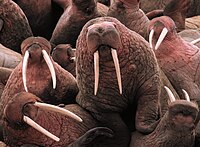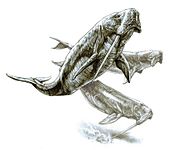Tusk

Tusks are elongated, continuously growing front teeth that protrude well beyond the mouth of certain mammal species. They are most commonly canine teeth, as with narwhals, chevrotains, musk deer, water deer, muntjac, pigs, peccaries, hippopotamuses and walruses, or, in the case of elephants, elongated incisors. Tusks share common features such as extra-oral position, growth pattern, composition and structure, and lack of contribution to ingestion. Tusks are thought to have adapted to the extra-oral environments, like dry or aquatic or arctic.[1] In most tusked species both the males and the females have tusks although the males' are larger. Most mammals with tusks have a pair of them growing out from either side of the mouth. Tusks are generally curved and have a smooth, continuous surface. The male narwhal's straight single helical tusk, which usually grows out from the left of the mouth, is an exception to the typical features of tusks described above. Continuous growth of tusks is enabled by formative tissues in the apical openings of the roots of the teeth.[2][3]
Other than mammals, dicynodonts are the only known vertebrates to have true tusks.[4]
Function
[edit]Tusks have a variety of uses depending on the animal. Social displays of dominance, particularly among males, are common, as is their use in defense against attackers. Elephants use their tusks as digging and boring tools. Walruses use their tusks to grip and haul out on ice.[5] It has been suggested that tusks' structure has evolved to be compatible with extra-oral environments.[1]
Size
[edit]
Elephant tusks are sexually dimorphic, being on average larger in males than in females, and entirely absent in female Asian elephants. Elephants with large tusks each at least 45 kilograms (99 lb) in weight are known as "tuskers", sometimes also called "big tuskers" or "great tuskers". While tuskers are rare today, it is thought that they were more common in the past, prior to human impact on elephant populations. The two record holders for longest and heaviest recorded African bush elephant tusks are around 3.49 metres (11.5 ft) long measured along the outside curve, and 107 kilograms (236 lb) in weight respectively, while the longest and heaviest Asian elephant tusks are 3.26 metres (10.7 ft) long and 73 kilograms (161 lb) respectively. Even larger tusks are known from some extinct proboscideans, such as species of Stegodon, Palaeoloxodon, and mammoths, with the longest tusk ever definitively recorded being that of a specimen of "Mammut" borsoni from Greece, which measures 5.02 metres (16.5 ft) in length, estimated to have weighed 137 kilograms (302 lb) when fresh, with some mammoth tusks exceeding 4 metres (13 ft) (and possibly 5 metres (16 ft) in the case of the Columbian mammoth) in length and probably 200 kilograms (440 lb) in weight.[6] The largest walrus tusks can reach lengths of over 95 centimetres (3.12 ft).[7] The longest narwhal tusks reach 3 metres (9.8 ft).[8] The upward curving maxillary tusks of babirusa can reach lengths of over 20 centimetres (7.9 in).[9]
Evolution
[edit]The ancestral arrangement of mammalian teeth is considered the most derived among vertebrates. Mammalian teeth features include crown morphology specialization (heterodonty), enamel, tooth-to-tooth occlusion, a single replacement event (diphyodonty), and a soft-tissue attachment between the teeth and the jaw. From this arrangement, mammals have evolved numerous morphological novelties like tusks.[4] Tusk is often used to describe the enlarged, paired maxillary caniniform teeth. For a tooth to be a tusk it must extend out from the mouth, be made solely of dentine, and grow continuously so it would regenerate if damaged or broken.[10] Tusks can function in many ways including defense, competition, burrowing, sexual selection, and locomotion.[11] A continuously growing tusk may have allowed dicynodonts to overcome the challenge of having one set of replacement teeth throughout their lives.[12] The first tusks are described in an earlier branching of non-mammalian synapsids known as the Dicynodonts. This clade diverged during the Permian Period and persisted until the Late Triassic. Dicynodont tusks exemplify the earliest known iteration of this morphological novelty, evolving well before the typical mammalian patterns of tooth attachment and replacement were established.[4] Dental examinations of fossils dating more than 200 million years ago support that the first tusks belonged to dicynodonts. Dicynodonts were distant relatives of mammals and were a very abundant and diverse group of vertebrates.[12] Tusks, in particular, have evolved convergently in multiple lineages of mammals and can be found today in many species.[11] Dicynodonts characteristically had beaks, composed of keratin, and a pair of “tusk-like teeth” protruding from their heads.[12] Most dicynodonts had two upper tusks that came down from the canine position and rarely any additional teeth. However, based on the criteria for a tooth to be considered a tusk, some dicynodont “tusks” were coated in enamel instead of dentin thus they didn't have tusks, just large teeth.[10] The earliest recognized ancestors of modern mammals with tusks had the second incisors of both upper and lower jaws enlarged to form small tusks. The lateral incisors, lower canines, and first premolars were already lost. The molars were low crowned, and their four cusps were united to form two prominent cross ridges.[11]
Dicynodont tusks are largely regarded as enamel-less and ever-growing, although there are a few reports of tusk replacement in some early dicynodonts. It is widely thought that Triassic dicynodonts acquired ever-growing tusks whereas earlier Permian-aged tusks were not ever-growing.[4] In contrast, regular mammalian teeth are also made of dentine but are coated in hard enamel, which precludes continuous growth. Enamel-covered teeth are more durable but irreplaceable; tusks can be used for fighting or digging because if they are damaged they can repair themselves and keep growing. The structure for tusks started emerging about halfway through the evolution of the dicynodont clade when some dicynodonts started developing soft tissue ligaments that connected the tooth to the jaw. Tusks then developed because of the reduced rates of tooth replacement that came from mandibular soft tissue ligaments.[10] With these two main developments, an ever-growing tooth allows an animal to get around the fact that it cannot replace the tooth. So, they evolved to deposit the same tooth tissue continuously, and as more tissue is deposited, the tooth begins to move outside of the mouth becoming a functional tusk.[13]
The earliest recognized ancestors of modern mammals with tusks had second incisors of both upper and lower jaws enlarged forming small tusks. It was observed that the lateral incisors, lower canines, and first premolars were already lost.[11] The most refined evolutionary scenario explaining tusk evolution exists for proboscideans. Early proboscideans had enlarged incisors that retained the plesiomorphic condition of being entirely capped with enamel. This enamel was restricted to a longitudinal band in more derived proboscidean taxa, suggesting a developmental shift towards continuous growth similar to modern rodent incisors. Multiple species derived from proboscideans are documented as independently losing enamel, resulting in the dentine-only tusk recognized in modern African and Asian elephants. This trend towards enamel reduction and continuous growth in the tusks of proboscideans represents one well-known possible evolutionary pathway.[4]
Use by humans
[edit]Tusks are used by humans to produce ivory, which is used in artifacts and jewelry, and formerly in other items such as piano keys. Consequently, many tusk-bearing species have been hunted commercially and several are endangered. The ivory trade has been severely restricted by the United Nations Convention on International Trade in Endangered Species of Wild Fauna and Flora (CITES).
Tusked animals in human care may undergo tusk trimming or removal for health and safety concerns.[14] Furthermore, surgical veterinary procedures to remove tusks have been explored to mitigate human-wildlife conflicts.[15]
Gallery
[edit]-
Skull of Babyrousa celebensis, showing long upward curving canine tusks
-
Tusks of a wild boar
-
Odobenocetops, an extinct whale with a long single tusk
See also
[edit]- Fang, a long canine tooth (in mammals)
- Ivory trade
- Eco-economic decoupling
References
[edit]- ^ a b Nasoori, Alireza (2020). "Tusks, the extra-oral teeth". Archives of Oral Biology. 117: 104835. doi:10.1016/j.archoralbio.2020.104835. PMID 32668361. S2CID 220585014.
- ^ "Tusk". The Oxford English Dictionary. 2010.
- ^ Konjević, Dean; Kierdorf, Uwe; Manojlović, Luka; Severin, Krešimir; Janicki, Zdravko; Slavica, Alen; Reindl, Branimir; Pivac, Igor (4 April 2006). "The spectrum of tusk pathology in wild boar (Sus scrofa L.) from Croatia" (PDF). Veterinarski Arhiv. 76 (suppl.) (S91–S100). Retrieved 9 January 2011.
- ^ a b c d e Whitney, M. R.; Angielczyk, K. D.; Peecook, B. R.; Sidor, C. A. (2021). "The evolution of the synapsid tusk: Insights from dicynodont therapsid tusk histology". Proceedings of the Royal Society B: Biological Sciences. 288 (1961). doi:10.1098/rspb.2021.1670. PMC 8548784. PMID 34702071.
- ^ Fay, F.H. (1985). "Odobenus rosmarus". Mammalian Species (238): 1–7. doi:10.2307/3503810. JSTOR 3503810. Archived from the original on 2013-09-15. Retrieved 2009-01-22.
- ^ Larramendi, Asier (2023-12-10). "Estimating tusk masses in proboscideans: a comprehensive analysis and predictive model". Historical Biology: 1–14. doi:10.1080/08912963.2023.2286272. ISSN 0891-2963. S2CID 266182491.
- ^ "Museum Bulletin | Carvings in Walrus Ivory". Museum Bulletin. Retrieved 2024-01-02.
- ^ Graham, Zackary A.; Garde, Eva; Heide-Jørgensen, Mads Peter; Palaoro, Alexandre V. (March 2020). "The longer the better: evidence that narwhal tusks are sexually selected". Biology Letters. 16 (3): 20190950. doi:10.1098/rsbl.2019.0950. ISSN 1744-9561. PMC 7115180. PMID 32183636.
- ^ Macdonald, Alastair A.; Shaw, Darren J. (April 2018). "Maxillary tooth growth in the adult male babirusa (genus Babyrousa )". Comptes Rendus Biologies. 341 (4): 235–244. doi:10.1016/j.crvi.2018.04.002. hdl:20.500.11820/2bc6b5c7-2057-4f6b-bd27-76e586756fe4. PMID 29752201.
- ^ a b c "Harvard-led study defines and traces their evolution from the first animals to sport them". The Harvard Gazette. 2021.
- ^ a b c d Weller, J. Marvin (1968). "Evolution of Mammalian Teeth". Journal of Paleontology. 42 (2): 268–290. JSTOR 1302214.
- ^ a b c "Fossils reveal how tusks first evolved and why they are unique to mammals". U.S. National Science Foundation. 2021.
- ^ "Fossil dental exams reveal how tusks first evolved and why they are unique only to mammals". Department of Organismic and Evolutionary Biology. 2021.
- ^ Rose, Josephine B.; Leeds, Austin; LeMont, Rachel; Yang, Linda M.; Fayette, Melissa A.; Proudfoot, Jeffry S.; Bowman, Michelle R.; Woody, Allison; Oosterhuis, James; Fagan, David A. (2022-03-03). "Epidemiology of Traumatic Tusk Fractures of Managed Elephants in North America, South America, Europe, Asia and Australia". Journal of Zoological and Botanical Gardens. 3 (1): 89–101. doi:10.3390/jzbg3010008. ISSN 2673-5636.
- ^ Mutinda, Matthew; Chenge, Geoffrey; Gakuya, Francis; Otiende, Moses; Omondi, Patrick; Kasiki, Samuel; Soriguer, Ramón C.; Alasaad, Samer (2014-03-10). Sueur, Cédric (ed.). "Detusking Fence-Breaker Elephants as an Approach in Human-Elephant Conflict Mitigation". PLOS ONE. 9 (3): e91749. Bibcode:2014PLoSO...991749M. doi:10.1371/journal.pone.0091749. ISSN 1932-6203. PMC 3948880. PMID 24614538.





